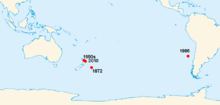Bahamonde beaked whale
| Bahamonde beaked whale | ||||||||||||
|---|---|---|---|---|---|---|---|---|---|---|---|---|

Mesoplodon traversii in size comparison |
||||||||||||
| Systematics | ||||||||||||
|
||||||||||||
| Scientific name | ||||||||||||
| Mesoplodon traversii | ||||||||||||
| ( Gray , 1874) |
The Bahamonde beaked whale ( Mesoplodon traversii ) is a species of whale from the family of the beaked whales (Ziphiidae).
Almost nothing is known about this whale species. They are considered to be the rarest whales in the world. From the findings it is concluded that the range includes the southern Pacific , and based on the skulls, the length of the Bahamonde beaked whale is estimated to be around 5.5 meters.
proof
In 1986 the skull of an unknown species of beaked whale, described as Mesoplodon bahamondi , was found on the Juan Fernández Archipelago, which belongs to Chile . Later investigations showed that the species is identical to a species discovered in New Zealand in 1874 , of which only jaw parts and teeth were found. Another skull find, made in New Zealand in the 1950s and lying unidentified in the camp of the University of Auckland for decades , is also of this type.
In December 2010, two beaked whales were washed ashore on Opape Beach in the north of New Zealand's North Island and died a short time later. It was a five-foot-long female and her five-foot-long male calf, which were first thought to be camperdown whales . Using DNA analysis, New Zealand scientists were later able to show that the stranded animals were Bahamonde beaked whales, which had never been seen before.
features
The adult female of the Bahamonde beaked whale differs little from other, related species of the beaked whale: back, fins and beak are dark, the belly is white. The shape of the mouth line, the dorsal fin and the flippers are similar to those of the camperdown whale ( Mesoplodon grayi ). Mesoplodon traversii can be distinguished from this species by a more conspicuous melon , which is more similar to that of the Layard whale ( M. layardii ), and by the color of the snout, which is dark gray or black in Mesoplodon traversii in adult specimens of the Layard whale but is whitish. Further features are the dark region around the eyes, the white belly and the dark flippers. The juvenile resembles those of all other two-toothed whales ( Mesoplodon ). Young animals are indistinguishable from one another in freedom.
Web links
- Sensational find off New Zealand ( Memento from February 10, 2013 in the Internet Archive )
- Mesoplodon traversii onthe IUCN 2013 Red List of Threatened Species . Listed by: Taylor, BL, Baird, R., Barlow, J., Dawson, SM, Ford, J., Mead, JG, Notarbartolo di Sciara, G., Wade, P. & Pitman, RL, 2008. Retrieved on December 29, 2013.
Individual evidence
- ↑ AL van Helden, AN Baker, ML Dalebout, JC Reyes, K. Van Waerebeek, CS Baker: Resurrection of Mesoplodon traversii (Gray, 1874), senior synonym of M. bahamondi Reyes, Van Waerebeek, Cardenas and Yanez, 1995 (Cetacea : Ziphiidae) . In: Marine Mammal Science . 18, No. 3, July 2002, pp. 609-621. doi : 10.1111 / j.1748-7692.2002.tb01062.x .
- ↑ a b Thompson, K., Scott Baker, C., van Helden, A., Patel, S., Millar, C., Constantine, R .: The world's rarest whale . In: Elsevier (Ed.): Current Biology . 22, No. 21, November 6, 2012, pp. R905-R906. doi : 10.1016 / j.cub.2012.08.055 .
